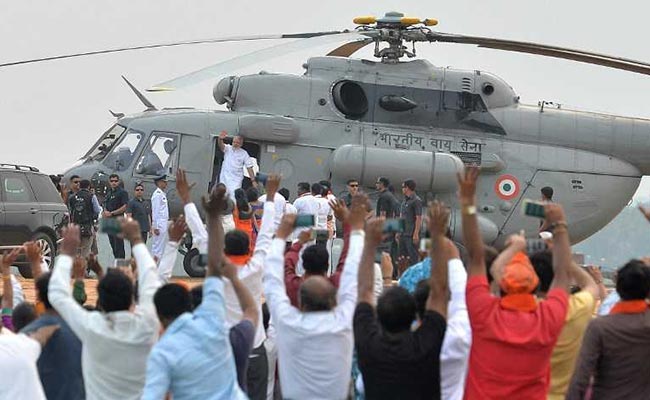With all parties opting for top-heavy candidates' lists made up of industrialists, realtors, mining and education barons, Karnataka elections have always been a high-spending affair.

Congress MLA Priya Krishna (first row, third from right), one of the richest candidates in the Karnataka elections, campaigns in Bengaluru.
A senior functionary of a national party broadly explained to this correspondent the two tiers of spending that candidates are required to do.
A basic tier of spending for each candidate, on an average, would work out to about Rs 3.5-Rs 4 crore per seat, he explained.
The bulk of this spending takes place during the last 10 days before voting day. On an average, he said, the daily expenses per day for these 10 days is Rs 25 lakh.

PM Narendra Modi arrives in a helicopter for a rally for the Karanataka assembly elections.
Rs 10,000 x 250 booths = Rs 25 lakh.
Rs 25 lakh x 10 days = Rs 2.5 crore.
In addition, the candidate would also have to spend for their own campaign - rallies, road shows, publicity and so on, which may (depending on the candidate, and nature of contest) come to another crore of rupees or more. Hence, the figure of Rs 3.5-4 crore per seat.
This is already approximately 14 times higher than the official expense ceiling set by the Election Commission of Rs 28 lakh per candidate.

The ruling Congress faces a tough challenge from the BJP in the Karnataka elections.
Increasingly, however, voters in southern states like Karnataka expect cash handouts which push up costs further.
More math is involved here, he explained, using a prestige constituency being fought by a heavyweight leader of a national party as an example.
In that constituency, the approximate number of voters is 2 lakh. Assuming a voter turnout of 70 per cent, the actual number of voters is about 1.4 lakh.
Deducting 40,000 voters as "write offs" loyal to the rival party, leaves a figure of 1 lakh.
From this, the candidate would deduct about 20-30,000 of what are known (somewhat crassly) as 'class' voters, those who would disdain cash handouts.
This brings the figure of voters to be targeted to about 70-80,000.
It may not be possible to cover all before voting day, so effectively cash handouts would reach about 50-60,000 voters.

The BJP has gone all-in in its Karnataka election campaign to usurp the Congress.
If however the demand (or the candidates willingness to pay) is for Rs 5,000 per voter, as is the case in some prestige contests (including the example cited above), then it pushes up costs to a whopping Rs 25-30 crore.
There are about 20 such high-spending "Rs 5,000-per-voter"seats in Karnataka, he said, about 10 per cent of all seats.
The expenses in those 20 seats alone, on an average of two main candidates per seat, works out to Rs 1,000-1,200 crore.
Seen in this context, it is clear why the Commission's seizure of Rs 152 crore, while admirable, is only the tip of an iceberg.
Which leaves us with a larger question that haunts every election: how, despite strengthened vigilance measures (and a one-time disruptive move like demonetisation) unaccounted money manages flow so freely during election time.
More on that in another column.


